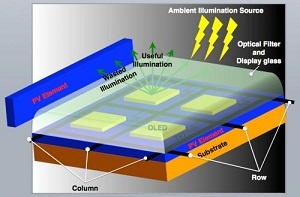 With all the emphasis on processing and network speed, perhaps the biggest challenge in smartphone design today is energy efficiency.
With all the emphasis on processing and network speed, perhaps the biggest challenge in smartphone design today is energy efficiency.
Multitasking operating systems running on Multi-core processors, combined with 4G data connections, can severely limit the usefulness of a phone if you don't have access to a computer, wall outlet, or car battery to charge it in the middle of the day.
Some mobile operating systems, use scaled back multitasking and lower power processors to address the issue. The iPhone 4S is notable for underclocking its processor to increase batter life at the expense of performance. Android phones, on the other hand, tend to sacrifice battery life in favor of performance.
Now researchers at the Cambridge Centre for Advanced Photonics and Electronics are experimenting with harnessing wasted light from OLED panels as a secondary power source. They have accomplished this through the use of solar cells built into the display panel, which are used to charge a capacitor.
OLED seems to be the undisputed future of flat panel displays thanks to its capability to reproduce a larger gamut of colors and consume less power. It has been the display type of choice for numerous high end smartphones, but so far it hasn't really lived up to its potential.
Thanks to being relatively immature technology, current OLED implementations are actually outperformed, power-wise, by the LCD displays favored by Apple for the iPhone. This Cambridge research looks like it has the potential to at least equalize the two technologies in that respect, perhaps representing a major milestone in smartphone development.
Some mobile operating systems, use scaled back multitasking and lower power processors to address the issue. The iPhone 4S is notable for underclocking its processor to increase batter life at the expense of performance. Android phones, on the other hand, tend to sacrifice battery life in favor of performance.
Now researchers at the Cambridge Centre for Advanced Photonics and Electronics are experimenting with harnessing wasted light from OLED panels as a secondary power source. They have accomplished this through the use of solar cells built into the display panel, which are used to charge a capacitor.
OLED seems to be the undisputed future of flat panel displays thanks to its capability to reproduce a larger gamut of colors and consume less power. It has been the display type of choice for numerous high end smartphones, but so far it hasn't really lived up to its potential.
Thanks to being relatively immature technology, current OLED implementations are actually outperformed, power-wise, by the LCD displays favored by Apple for the iPhone. This Cambridge research looks like it has the potential to at least equalize the two technologies in that respect, perhaps representing a major milestone in smartphone development.














